Where I live, far from avocado country, it’s not unusual for organic avocados to be $2.50 or $3 each.
“Oh, waaah, you big crybaby,” locavore purists might argue, “avocados are expensive because you live in Seattle, so stop buying non-local food!”
To which I reply: “The zombies can have my guacamole when they pry it from my salt-covered, tortilla chip-holding fingers.”
In any event, if you are paying $3 for a single avocado, you want that avocado to be freaking perfect: soft but not bruised, fully ripe but not rotten.
But I suspect many avocado lovers have experienced, as I have, the disappointment of slicing into their avo only to find brown streaks or dark, rotten bruising on the inside.
Gross.
Here’s how to make sure that never happens again.
Before you commit to a specific avocado, look for all the external signs of ripe-but-not-rotten. With a Hass avocado (the variety we tend to get on the West coast), the skin should be very dark green-to-black and bumpy. The fruit should feel heavy and firm, with no obvious smooshy parts or flat areas.
Now here’s the trick. Once you’ve got a good candidate, take a sneak-peak at what’s inside. Discreetly flick the dry stem off the fruit.
If you see a brown patch under the stem, put that avocado back. It will be gross inside.
Like this:
But, if the fruit right under the stem is bright avocado yellow-green, you have a winner. Your avocado will be great.
Like this:
This technique has never failed me.
Haas avocados purchased hard and green will ripen nicely on the counter over several days. However, once your avocado hits that black-skinned stage, don’t delay in enjoying it. The difference between a soft and creamy avocado and a brown-streaked, half-rotten one is only a few days on the counter.
277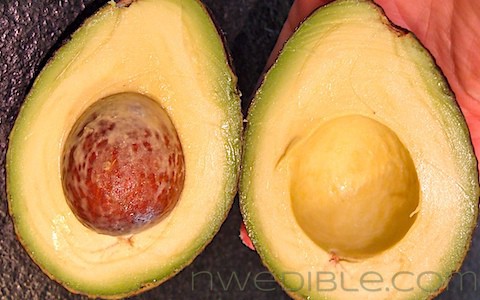
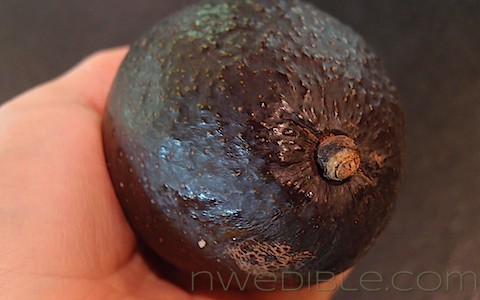
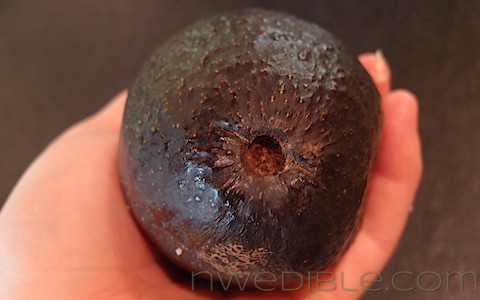
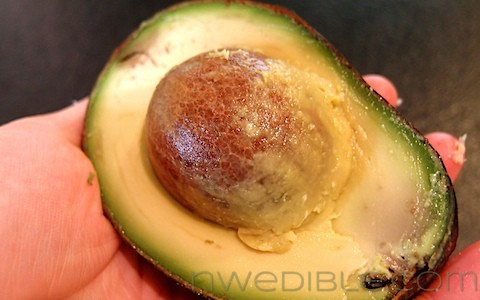
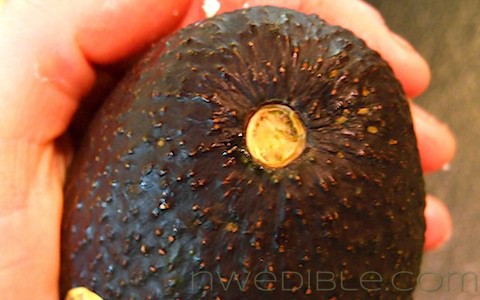
Perhaps someone has mentioned it above, but I ALWAYS return a bad avocado to where I bought it. I’ve never been turned away. They’re too durn expensive to just toss on the compost heap.
Rather than cut your avocado in half and spoon out the flesh, cut it in quarters top to bottom, take the pieces apart then peel the skin off like a banana.
Less waste and easier. In my opinion. This works best on a ripe room temperature avocado. Enjoy. 🙂
Thanks so much for the tip! I have avoided avocados like the plague because I was tired of literally throwing my money away.
Before she passed, My Grandma lived in west palm beach. There was a GIANT Shade tree in the back yard. There were times that you could NOT sit in the shade though, since it was an Avacado tree…I never saw such a large A-tree before, or since… more like pretentious bushes. That tree would produce a L O T of fruits….
-After she passed, the WPB Airport bought her house… ripped up the tree, and made a new approach… yea progress.
On topic though, make sure the grocery stocker is NOT watching… they tend to get annoyed if you flick bits off, then select something else…
Ok, another Seattlite here. My problem lately has been less on the brown rotten front, and more on the stringy front. I get these beautiful, perfectly soft, creamy, bright green avocados, but they’re so full of gross fibrous strings that I have to toss them. Thoughts???